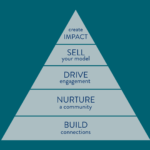There’s power in your database: Using emails to cultivate thought leadership
You’re here to get your ideas out there and start making a difference in your industry. You know emails are an important channel in your thought leadership journey – but how do you know you’re doing it right?
Thought leadership emails, above all, are about building consistency, trust and community around your ideas and your business. Here’s our mini crash course on creating a value-driven email strategy and why you don’t need to be scared of leveraging your database.
It’s not just marketing – it’s your chance to engage your ideas
We get it. There’s something just a little bit icky-feeling about the word “marketing”. It can make your emails or Linkedin posts feel like they’re only about driving sales or making money.
We don’t think of emails as solely a marketing tactic. Sure, they can absolutely help you grow your audience and bring traffic to your website – but the primary purpose of a thought leadership email isn’t about selling yourself. It’s about getting people to adopt your ideas – the ones that you know can help people live better lives and work more effectively.
Here’s the difference. Marketing emails are about presenting yourself, and making your product irresistible to your reader (and let’s be honest – if you’re growing a business then you’ll definitely still want some of these!). Thought leadership emails are about tapping into the needs, the worries, and the wants of your audience right now and shining your perspective onto them.
How do you create value-driven emails?
Always start by thinking about your audience. Consider what they are thinking about and feeling. What challenges are they facing? What changes are happening in their industry? What are they hoping to see happen in the near future?
Think about how your thought leadership positioning plays into these current conditions, and then use your idea of better as a lens to respond to those challenges.
Don’t ignore the hard or controversial topics – likely these are the things your audience is dying to hear more about from you. Tap into the stuff that’s on people’s minds – whether it’s how AI is changing the landscape of your profession, or how you’re seeing businesses deal with an economic downturn, or what people can do to reduce workplace stress.
Don’t underestimate your subject line
You’re probably heard it before, but it’s too important not to mention: Intriguing subjects draw attention. If you want to increase your open rates and engage more people with your ideas, then you need to put effort into your headings.
Here are a few fantastic examples from thought leaders we’ve either worked with or respect that show a few different approaches you can take.
- Value-driven and actionable, from Jude Sclater at Think with Jude:
“A quick way to encourage your team to be more creative and innovative”
- Honest and personal, from Mel Rowsell at Wisdom at Work:
“Mixed up and muddled up”
- Punny and bite-sized, from Michael Roderick at Small Pond Enterprises:
“Choose Your Own Add-Venture”
- Direct and urgent, taken from our own most-opened email:
“Are you showing up? This is why consistency is key.”
How many is too many?
It’s one of the most common questions we get when it comes to outreach – whether it’s social media posting or leveraging a database. And honestly, there’s no hard and fast answer. Every industry and community has slightly different expectations and norms when it comes to how (and how much) they’re engaging with their inbox or on Linkedin.
The thought leaders we work send anywhere from two emails a month to two a week – and there are benefits and risks to both ends of that spectrum.
To figure out where the right frequency sits for your business, start by considering your own habits and what you know about your audience’s routines. What emails do you open religiously? Would you open them even more frequently if you received more? What makes those gems in your inbox different from the ones you delete the second you see them pop up?
You want to find a balance between keeping your audience engaged consistently without flooding their inbox. It’s OK to start slower and build your way up to a higher frequency once you know that you have a captivated audience waiting for you.
And yes, you can still plug your offerings
Remember that part of thought leadership means encouraging people to engage with your ideas further. As you draft your emails and build consistency with your regular communications strategy, don’t forget that you also need to connect these tiny slices of insight to your business.
Amidst all the value and the honesty you’re giving to your audience through your emails, you still need to show your reader how they can tap into more of you.
This can be as simple as a link to your website, or an invitation to reach out to you directly to book a call. If you’ve just launched a new offering, such a book or course or blog, that will probably warrant an email of its own.
And on that note…
If you’re looking to develop your thought leadership strategy and build a bigger impact, then you’re in the right place. Follow the link to book a free game plan call with one of our team!


